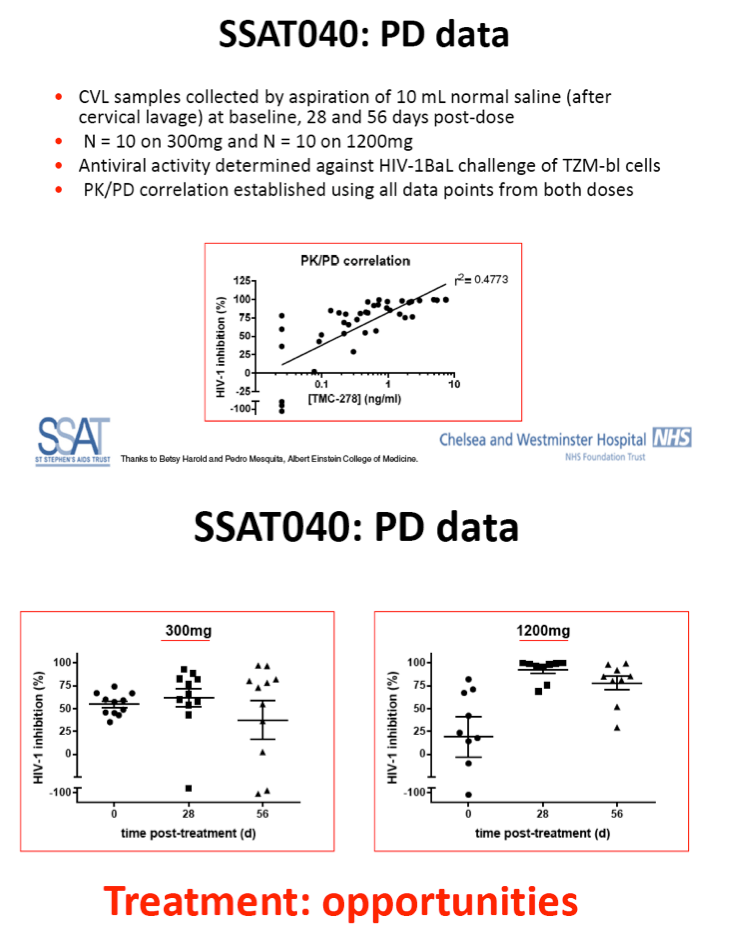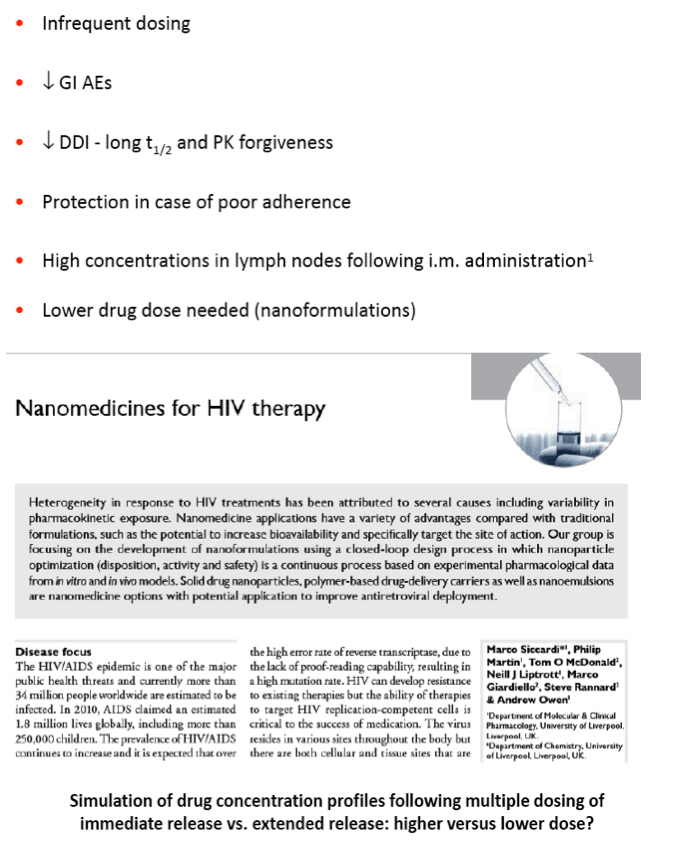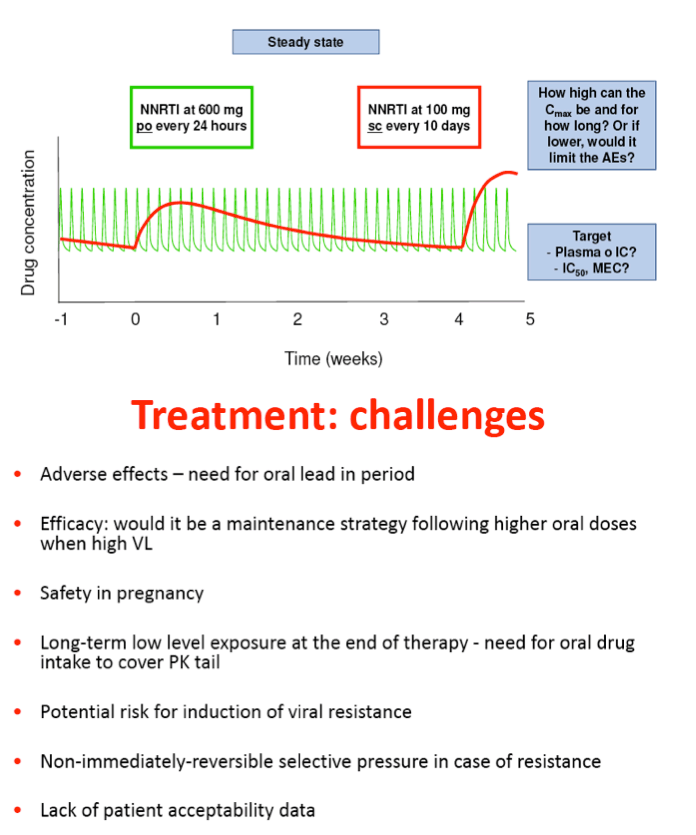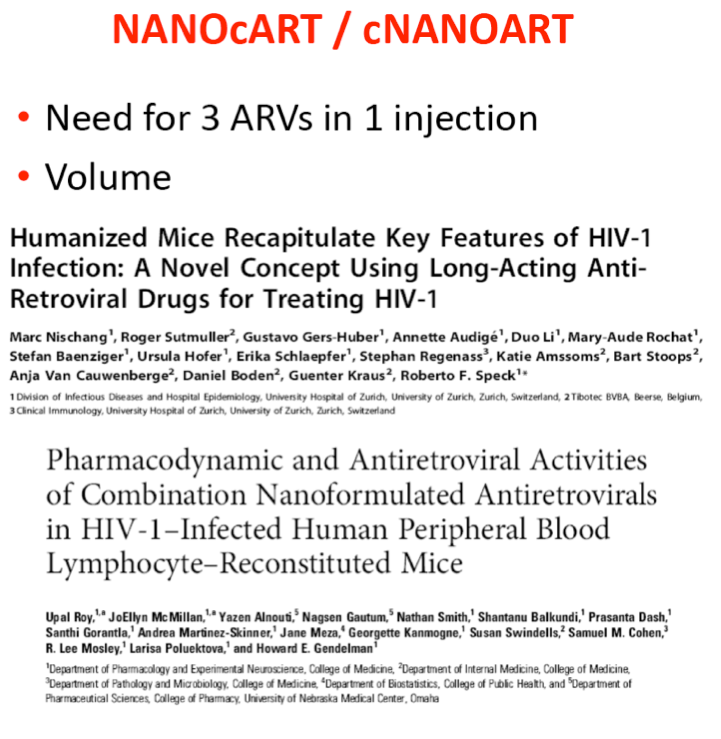 |
 |
 |
| |
New Approaches to ART Drug Delivery: long-acting ARTs, nanoparticles
|
| |
| |
Link to webcast
http://webcasts.retroconference.org/console/player/19414?mediaType=podiumVideo
Challenges and Opportunities for the Development of Long-acting ARVs
Marta Boffito
Chelsea and Westminster Hosp, London, UK
Background: Research on improved treatment of HIV infection and pre-exposure prophylaxis (PrEP) continues. Poor adherence to treatment is the critical risk factor for virologic failure and resistance development, and long-acting formulations of anti-HIV medications that need only infrequent dosing may facilitate long-term therapeutic responses. However, such formulations and long-term persistence of drug are associated with challenges, such as safety and selective pressure of the drug in case of resistance.
Conclusions: To prevent transmission of HIV, long-acting injectable formulations of ARV agents with infrequent dosing may be advantageous over daily oral drug intake. However, the knowledge on protective drug concentrations and frequency of dosing is poor to date and implementation globally is challenging.
Enhanced Pharmacological Properties of Efavirenz Formulated as Solid Drug Nanoparticles
P Martin1, Neill Liptrott1, T McDonald1, M Giardiello1, P Roberts1, P Curley1, D Smith2, M Siccardi1, S Rannard1, and A Owen1
1Univ of Liverpool, UK and 2Univ of Northumbria, Newcastle Upon Tyne, UK
Background: Solid drug nanoparticles (SDN) have potential to increase bioavailability and improve pharmacokinetics (PK) of ARV drugs. Using an emulsion-templated freeze-drying technique, we report here a pharmacological assessment of an efavirenz (EFV) SDN. Additionally we examined immune interactions as an early safety assessment of these new formulations.
Methods: Transcellular permeation across Caco-2 cell monolayers and cellular accumulation in primary cell types were assessed with 10 μM EFV SDN or conventional solution. The pharmacological activity of the EFV SDN and solution were assessed using recombinant reverse transcriptase (cell-free) and HIV-IIIB+ MT4 cells (cell-based). Cellular proliferation, activation, and function was assessed in CD4+ and CD8+ T cells as well as monocyte-derived macrophages (MDM) as part of a putative safety assessment. Finally, the PK of EFV SDN relative to a conventional formulation (0.5% methylcellulose) was assessed in rats after oral dosing (10 mg/Kg, 4μCi.mg). Data analysis was conducted using GraphPad Prism 3.0 and StatsDirect software.
Results: Transcellular permeation through Caco-2 monolayers was lower in basolateral to apical (blood to gut) and higher in apical to basolateral (gut to blood) direction for SDN compared to conventional solution. Cellular accumulation of the EFV SDN was significantly higher than solution in all cells studied e.g., primary hepatocytes (1.9-fold; p <0.0001) and CD4+ cells (2.1-fold; p <0.0001). Activity in the cell-free system was comparable for SDN (IC50 = 112.8 nM) and solution (IC50 = 123.3 nM) but activity against HIV-IIIB in MT4 cells was higher for SDN (IC50 = 16.4 nM) than solution (IC50 = 71.3 nM), consistent with the parallel observation of a higher accumulation in MT4 cells. No difference between EFV SDN and solution was observed for their impact on CD4+, CD8+ T cells, or MDM activation. The SDN exhibited higher Cmax (478.1 vs 125.9 μg/L), Cmin (378.9 vs 80.5 μg/L), and AUC (1831.0 vs 457.1 μg/L-h) and decreased Tmax (0.5 vs 0.8 hours) compared to a conventional formulation in rats.
Conclusions: We have generated an EFV SDN with improved bioavailability, in vitro cellular distribution and enhanced antiviral activity compared to dissolved EFV. No obvious adverse immune interaction for this EFV SDN were uncovered in CD4+, CD8+, or MDM cells. Studies to determine whether bioequivalence can be obtained with a lower dose of SDN are now p
lanned in healthy volunteers.
Development of Small Magnetite ARV Nanoparticles for Targeted Drug Delivery to Viral Reservoirs
Dongwei Guo, T Li, J McMillan, M Boska, X Liu, and H Gendelman
Univ of Nebraska Med Ctr, Omaha, US
Background: Drug toxicities, compliance, and limited penetrance into viral reservoirs have limited long-term ART effectiveness. To this end, our laboratories have manufactured long-acting nanoformulated ART (nanoART) to improve drug adherence and disease outcomes for infected people. The long-term goal is to target then eliminate virus in reservoirs of infection not accessible by native drug administrations. We posit that small magnetite antiretroviral therapy (SMART) can provide a "rapid screening tool" for noninvasive assessments of ART distribution. This would be made possible by SMART magnetic resonance imaging (MRI) techniques.
Methods: Poly(lactic-co-glycolic acid), 1,2-distearoyl-sn-glycero-3-phosphocholine and 1,2-distearoyl-sn-glycero-3-phosphoethanolamine-N-[methoxy(polyethylene glycol)-2000] encased SMART particles were manufactured containing atazanavir (ATV) and ultra small paramagnetic iron oxide (USPIO) and dissolved in chloroform. An emulsion made in polyvinyl alcohol solution was sonicated to effect particle size. SMART iron and drug release was determined in phosphate-buffered saline and in human monocyte-derived macrophages (MDM) by UPLC-MS/MS and Prussian blue, respectively. Following parenteral (intravenous) SMART injection (30 mg/kg ATV) Balb/c mice were imaged by MRI up to 24 hours. T2 maps and a 3D spoiled gradient recalled echo image set (3D-GRE) were acquired prior and after to SMART injections. T2* weighted 3D MRI sequences were compared to tissue ATV drug levels.
Results: SMART particles were manufactured with ATV and USPIO loading enabling sustained drug release. SMART particles were efficiently taken by and retained in MDM over two weeks. In mice, SMART T2 weighted images showed that iron concentrations reflected vascular content at early, 4 hour, time periods. However, by 24 hours signal intensity was seen in liver and spleen with little to no USPIO in the kidneys. Most importantly ATV levels in liver, spleen, lung, brain, and kidney correlated directly with ∼T2 MRI iron content measures.
Conclusions: We posit that SMART particles can be developed for noninvasive evaluation of drug distribution and pharmacokinetics. These particles show clear potential in allowing a rapid evaluation of ART content in viral reservoirs that include the brain and lymphoid tissues. Improve in particle delivery have been seen in cell and tissue targeted particles with coated ligands and sugars for future viral elimination studies.
Improved Biodistribution, Pharmacokinetics, and ARV Responses for Folate-targeted Nanoformulated ART
Pavan Puligujja, H Gendelman, L Kendrick, N Smith, S Balkundi, U Roy, R Veerubhotla, J McMillan, and X Liu
Univ of Nebraska Med Ctr, Omaha, US
Background: Penetrance to viral reservoirs, inherent drug toxicities, viral resistance, regimen adherence, and the failure to eradicate latent infections have limited ART effectiveness. To this end, our laboratories developed cell and tissue targeted nanoformulated ART (nanoART). However, while mononuclear phagocytes (MP) readily uptake, store, and release ART encased particles, the system was limited in particle uptake and sustained delivery necessitating high injection drug concentrations to achieve sustained plasma and tissue drug half lives. To overcome these we chemically modified nanoART formulations (atazanavir [ATV] and ritonavir [RTV]) with an MP-receptor targeted vitamin, folic acid (FA).
Methods: The carboxylate moiety of FA was covalently attached to the poloxamer 407 hydrophilic sites through amidation. Product purification was by size exclusion chromatography and nanoparticles made by high-pressure homogenization. Size, polydispersity index, and zeta potentials were determined. The particle integrity and shape were confirmed by 1H nuclear magnetic resonance and scanning electron microscopy. Monocyte-derived macrophages (MDM) purified by elutriation were used to assess particle uptake, release, and ARV responses. Balb/c mice were injected intramuscularly to determine drug pharmacokinetics.
Results: Particle size ranged from 300 to 400 nm, zeta potential from -4 mv to -26 mv, polydispersity index from 0.11 to 0.30. FA nanoART demonstrated up to 2-fold increased ATV and RTV uptake and ARV activities in cell-based laboratory assays. However, increases of ART of up to 10-fold over non-conjugated particles were seen in plasma, lung, liver, kidney, spleen, lymph nodes, and brain for 2 weeks after a single intramuscular injection. CF633-labeled nanoART demonstrated localization in MP (notably, Kupffer cells) after in vivo administration.
Conclusions: We posit that FA-targeted nanoART can improve ART biodistribution and stability with a long-term of viral reservoir eradication. Such treatment measures can prolong dosing intervals and improve ART patient adherence.
Challenges and Opportunities for the Development of Long-Acting ARVs
Marta Boffito
London, UK, Chelsea & Westminster Hospital











|
| |
|
 |
 |
|
|